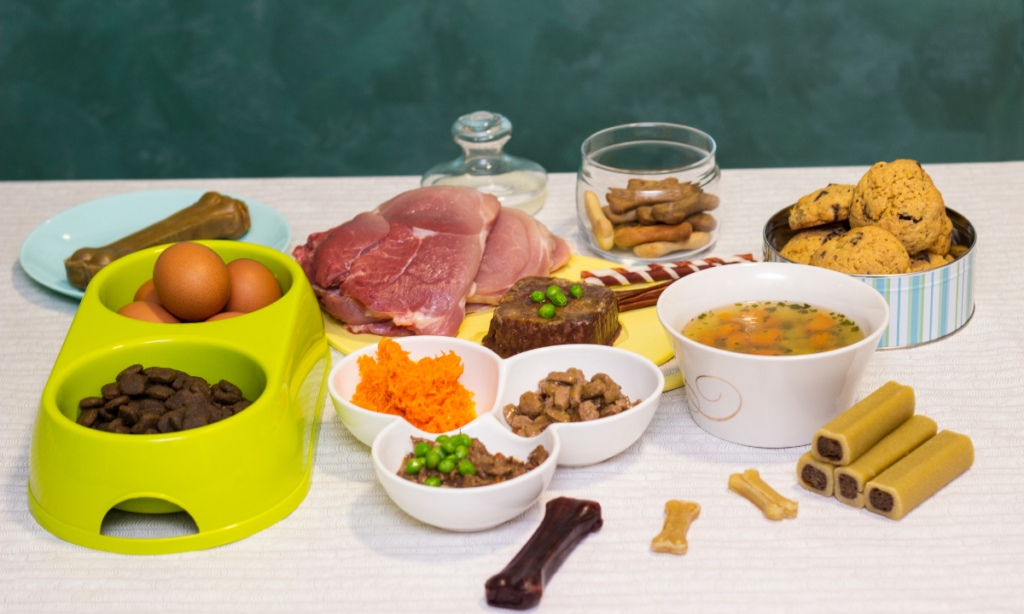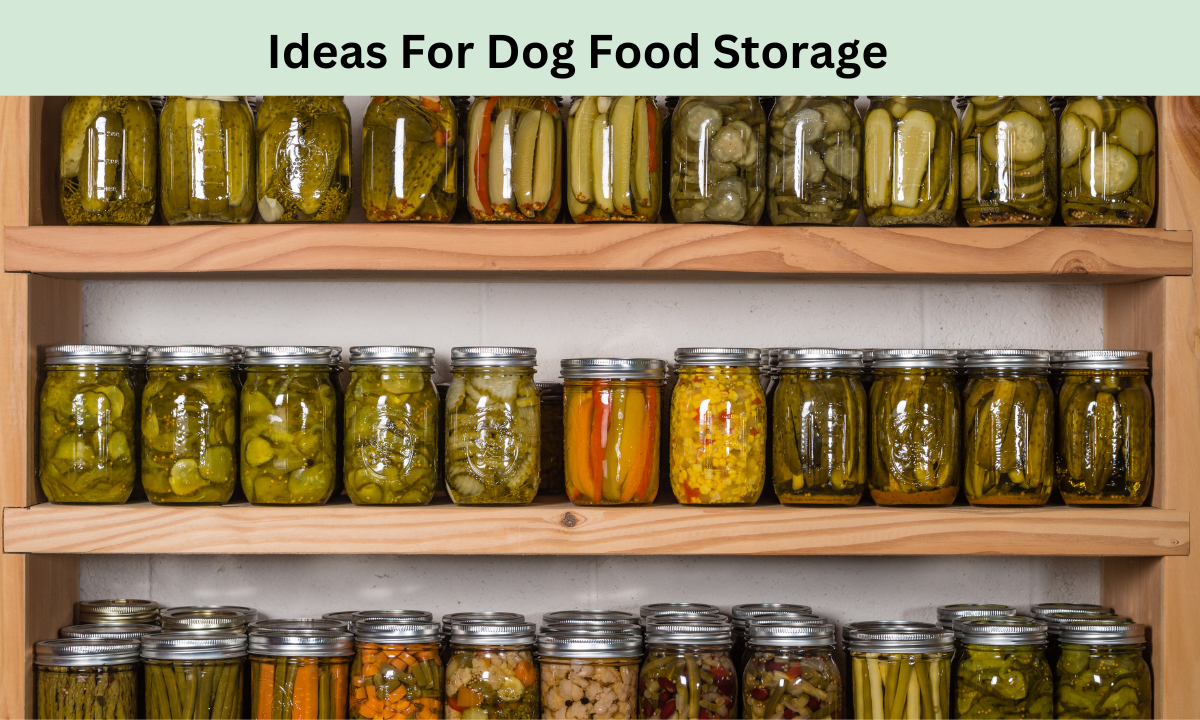Storing dog food properly is important to maintain its freshness and quality. It ensures the health and happiness of our dogs. This article will cover a few important and effective ideas for dog food storage at home. It will discuss storage methods in various areas such as the kitchen, garden, and garage so that the dog’s meal remains safe and nutritious. Proper storage prevents contamination and protects food from pests and moisture that may impact food quality.
Awesome Ideas For Dog Food Storage

Below, we have discussed some of the most useful storage ideas for dog food:
Storing dry dog food in the kitchen
Keeping dry dog food storage ideas for small spaces like in the kitchen is convenient for serving meals. However, storing them in a closed container away from direct sunlight, moisture, and heat sources is important to avoid any nutrient loss.
An airtight plastic container placed in the kitchen’s cool, dry corner ensures dry food stays fresh for longer. Large containers with tight-fitting lids prevent spills and stop pests from entering. As the kitchen often gets warm, food stored here must be checked regularly for any signs of dampness due to heat and moisture. Rot-proof and pest-proof storage are necessary to maintain dry dog food’s quality and shelf life.
Storing Wet Dog Food in the Refrigerator
Since wet dog food contains high moisture content, refrigerating partially used pouches or cans is recommended. It slows down the growth of bacteria and spoilage by lowering the temperature.
Wet food must be kept in a sealed, airtight container in the refrigerator’s vegetable drawer, which remains among the coldest areas. Marking used containers with dates is important for first-in-first-out use and to keep track of freshness duration.
The refrigerator provides a cool and hygienic storage environment for wet food. However, very large bags may not fit and are better kept in the freezer in such cases. Regular cleaning of the refrigerator also ensures wet food is free from contamination.
Storing dog food in the garden shed or garage
For many owners, the garden shed or garage provides additional storage space than the home. Outdoors, direct sunlight and heat are the major concerns for food quality. A well-ventilated and covered area protects from the elements.
Food must be kept in airtight containers with tight-fitting lids on raised surfaces away from direct floor contact and moisture. Regular inspection ensures no signs of chewing or leaks by pests and leakage. Outdoor ideas for dog food storage requires more frequent quality checks and relocating indoors if any issues are noticed. Rot-proof and pest-proof containers are essential for effectively using a garden or garage for long-term food storage.
Storing large bags of dry dog food
Large bags of dry dog food often come in sizes of 25 pounds or more. They can be difficult to store while maintaining freshness. It’s best to keep these big bags in a lidded plastic tote in a cool, dry place like the garage or basement. The plastic tote protects the bag from moisture and pests.
Some owners even place a few silica gel packets inside the tote to absorb excess moisture. It’s a good idea to transfer some dry food from the large bag to an airtight container for use in the kitchen. This prevents multiple openings of the large bag, which can cause the food to get stale faster. The remaining bag in the tote can be sealed tightly and stored long-term while maintaining quality and freshness.
Proper storage for treats and chews
Just like regular dog food, it’s important to store treats and chews appropriately for freshness and to prevent contamination. Hard chew treats can be kept in an airtight glass or plastic jar in the pantry or kitchen cabinet away from heat and direct sunlight.
Softer chew treats like bully sticks should be kept wrapped in the refrigerator. Dental treats need proper sealing, too, to maintain freshness. Freezing is another great way to preserve treat texture and shelf life. Rotation is important so older treats are used before they expire. Treat storage also requires keeping young children out of reach for safety. Proper ideas for dog food storage extends the usability and improve the quality of all types of dog treats and chews.
Storing homemade dog food
If one prepares homemade dog food, there are additional storage precautions to follow. Perishable ingredients like meat and dairy require refrigeration within 2 hours of cooking. Portion individual meals into sealed freezer bags or containers and label with content and date.
The freezer provides 3-4 months of storage. For non-perishable homemade batches, an airtight container in the refrigerator or a cool, dark pantry shelf for 2-3 weeks is suitable. Regular quality checks are essential as homemade food can spoil faster without preservatives. It’s best not to prepare large batches at once. Rotating stocks ensures the freshest meals for the furry companion. Proper ideas for dog food storage protect the time and effort invested in homemade dog food.
Wrap Up
Following proper storage ideas for dog food and maintaining ideal temperature and moisture-free conditions helps keep dry and wet dog foods fresh for longer—regular inspection of stored food aids in the early detection of any quality issues. Choosing suitable storage areas based on food type and using airtight containers protects nutrition. Storing food effectively enhances our pet’s well-being and health by safely consuming a balanced and high-quality diet. With regular monitoring and preventive storage, owners can ensure their furry best friend always has access to safe and nutritious meals.
Frequently Asked Questions (FAQs)
How do you store leftover dog food?
Make sure it doesn’t get hotter than 80 degrees where you decide to store it. Keep leftovers in the fridge: Refrigerate any leftovers or open containers if your dog consumes wet food. Temperatures below 40 degrees Fahrenheit will prevent bacteria from growing in the refrigerator.
What is the best way to store dog food?
Dry pet food and unopened canned food should be kept in a cool, dry location. It should be no more than 80 degrees Fahrenheit. The nutrients could degrade if there is too much heat or moisture present. Store your pet’s food in a secure area if they are very persistent or resourceful in getting at it.
Can I store dog food in a plastic container?
plastic toxic substances can harm dogs, it’s important to ensure that plastic food storage containers are free of BPA and other plastic contaminants.
Is metal safe for dog food storage?
A more durable, sturdy product that does not release harmful chemicals into the environment or your dog’s food is a metal container. Not only are metal food containers fit for your dog, but they are also environmentally friendly because they can be recycled.
Also read:


